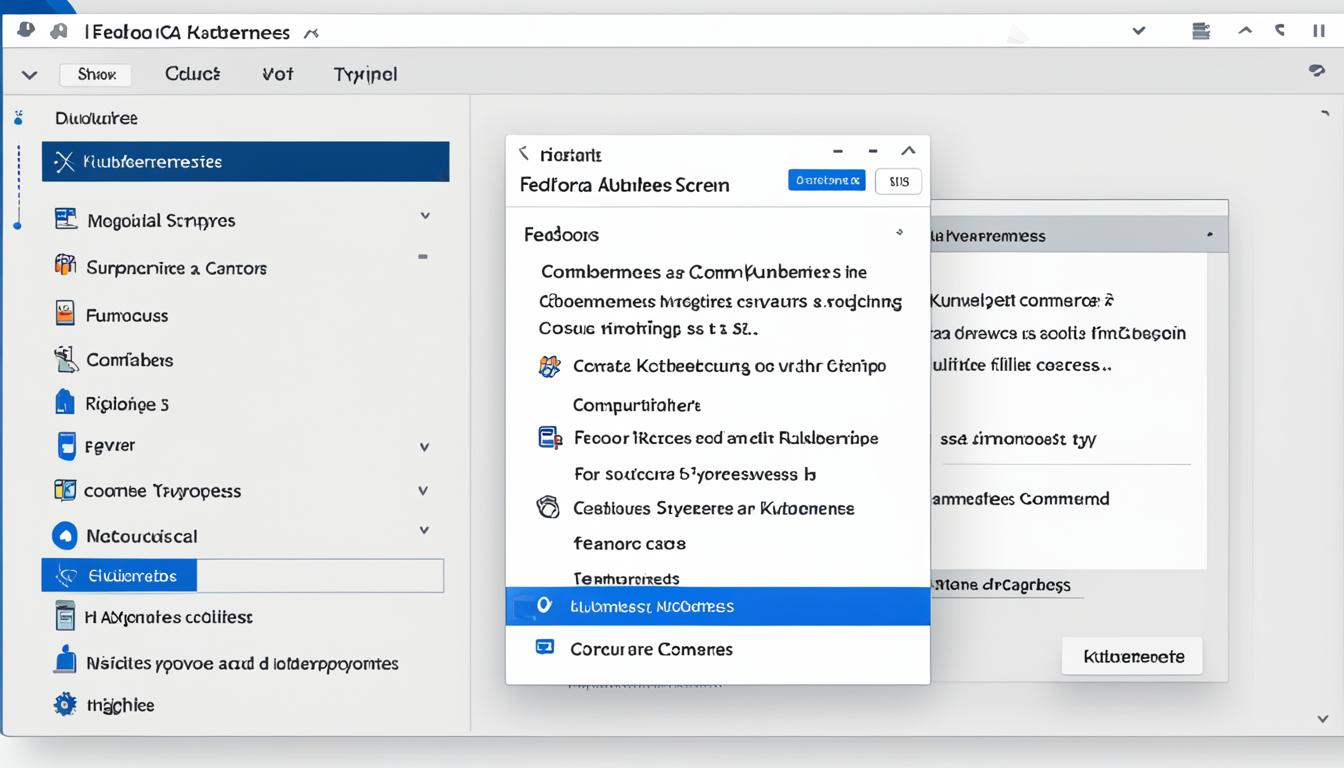Install Kubernetes on Fedora 38: Step-by-Step Guide
Are you ready to start your journey to master container orchestration with Fedora 38? This guide will show you how to create a basic Kubernetes cluster step by step. Ever wondered how to run Kubernetes smoothly on Fedora? This guide makes it easy to set up Kubernetes. You’ll learn how to use open-source software for your development needs. Follow these steps to integrate Kubernetes with Fedora 38. You’ll boost your skills in managing containerized applications. This tutorial is perfect for both seasoned developers and beginners.
Key Takeaways
- Understand the prerequisites for a successful Kubernetes installation on Fedora 38.
- Learn how to update system packages for optimal performance.
- Discover the steps to install essential Kubernetes packages: kubeadm, kubelet, and kubectl.
- Master the configuration of your Kubernetes cluster.
- Find out how to disable swap and firewall to ensure Kubernetes compatibility.
- Deploy a containerized application with ease.
Introduction to Kubernetes
Kubernetes, or K8s, is a key open-source platform for automated deployment, scaling, and management of containerized applications. It started from Google’s top container management methods. Now, it’s a strong ecosystem run by the Cloud Native Computing Foundation.
Exploring Kubernetes deployment shows its role in making systems resilient and scalable. It manages containerized apps across many machines. This makes it great for small home labs and big enterprise clouds.
Kubernetes is versatile, fitting many needs. It’s a must-have for developers and operations teams. Whether setting up or managing big clusters, containerized applications management with Kubernetes is top-notch.
Adding Kubernetes to your workflow means learning how to install and set it up. A detailed guide can help you get started. This ensures a smooth move to managing containerized apps with Kubernetes.
Prerequisites for Installing Kubernetes on Fedora 38
Before you start installing Kubernetes on Fedora 38, make sure your system is ready. You need to check both the system and software requirements.
System Requirements
For a smooth setup, check if your machine meets the minimum specs. The ideal setup includes:
- CPU: At least 2 CPUs
- Memory: More than 2GB of RAM
- Disk Space: At least 20GB free space
- Network: A stable network connection
Software Requirements
For a successful Kubernetes setup, you need the right software. First, update your system packages. Then, install the following software:
- Kubernetes Packages: Use dnf to install
1kubernetes-node
,
1kubernetes-kubeadm, and
1kubernetes-client.
- Docker: Make sure Docker is installed and running for containerized apps.
- Swap Space: Turn off swap space for Kubernetes setup.
Meeting these requirements sets you up for a successful Kubernetes installation. Good planning and following these steps will make setup easier and avoid problems.
Install Kubernetes on Fedora 38
To start the Fedora 38 tutorial on installing Kubernetes, make sure your system is up-to-date. You’ll need to run a few commands and install specific packages for a k8s on Fedora cluster.
Updating System Packages
First, update your system packages. This keeps all software current and lowers the chance of compatibility problems. Here’s how to do it:
- Open a terminal window.
- Run the following command to update the system:
This command gets the latest versions of all packages. Your system is now ready for installing Kubernetes packages.
Kubernetes on Fedora has more info on what you need before starting.
Installing Required Kubernetes Packages: kubeadm, kubelet, and kubectl
With your system updated, install the core Kubernetes software. Fedora has the needed packages ready in its repositories. You’ll need:
- kubeadm
- kubelet
- kubectl
Install these with this command:
Now, you have the main tools to manage a Kubernetes cluster on Fedora. Note, for Fedora 39 and earlier, package names might be different. But, starting with Fedora 40, the setup is simpler.
For a full guide on creating a cluster, check the detailed tutorial on the Fedora Project site.
Configuring Your Kubernetes Cluster
After installing the needed Kubernetes packages, it’s time to set up the cluster. A well-planned setup ensures your cluster runs smoothly and can grow as needed.
Initializing the Kubernetes Cluster with kubeadm
The kubeadm initialization starts with a single-node cluster. Use the
1 | kubeadm init |
command to begin. It’s crucial to set up your Kubernetes correctly at this stage to prevent mistakes. Make sure to disable swap and adjust firewall settings before starting the initialization.

Setting Up the kubeconfig File
After initializing with kubeadm, setting up the
1 | kubeconfig |
file is next. This file lets
1 | kubectl |
talk to your cluster. Here are the steps to follow:
- Create the directory:
1mkdir -p $HOME/.kube
- Copy the configuration file:
sudo1<code>1cp -i /etc/kubernetes/admin.conf $HOME/.kube/config
- Set the right permissions:
1sudo chown $(id -u):$(id -g) $HOME/.kube/config
This makes the
1 | kubectl |
command work with your Kubernetes cluster. Pay close attention to these steps for a smooth cluster setup.
Disabling Swap and Firewall for Kubernetes Compatibility
Setting up your Fedora 38 for Kubernetes setup means turning off swap and tweaking the firewall. These steps are key for making Fedora 38 work well with Kubernetes. They help avoid problems when you deploy Kubernetes.
Disabling Swap
Kubernetes needs swap turned off on your system. This is because Kubernetes works best with systems without swap. On Fedora 38, you might need to stop zram as it’s often used for swap. Here’s what to do:
- Open a terminal and switch to root user:
-
1sudo su
- Turn off swap with this command:
-
1swapoff -a
- Edit
1/etc/fstab
to disable swap:
-
1nano /etc/fstab
- Find the swap line and add a
1#
at the start to disable it:
-
1# /swapfile swap swap defaults 0 0
- Save the file and reboot to make the changes take effect.
Disabling Firewall or Configuring Firewalld
Turning off the firewall makes starting your Kubernetes setup easier. But, you can also set up
1 | firewalld |
to open the needed ports for better security. Here are the steps for both:
Option 1: Disabling Firewalld
- Stop the firewall service:
-
1systemctl stop firewalld
- Make sure it doesn’t start again:
-
1systemctl disable firewalld
Option 2: Configuring Firewalld
- Open the needed Kubernetes ports with these commands:
-
1firewall-cmd --permanent --add-port=6443/tcp
-
1firewall-cmd --permanent --add-port=2379-2380/tcp
-
1firewall-cmd --permanent --add-port=10250-10252/tcp
-
1firewall-cmd --permanent --add-port=10255/tcp
- Apply the firewall changes:
-
1firewall-cmd --reload
These steps are key for Fedora 38 compatibility. Make sure to do them before setting up Kubernetes. Following these steps makes the Kubernetes setup on Fedora 38 smoother.
Deploying a Containerized Application
After setting up the Kubernetes cluster on Fedora 38, it’s time to deploy containerized apps. This guide will show you how to make a deployment file. It covers important details like the container image and how much resources it needs.
Creating a Deployment Configuration
Start by making a deployment file in YAML format. This file tells Kubernetes about your app, like what container image to use and other important settings. For more help, check out guides on Reintech.io. This step is key in managing containers.
Applying the Deployment with kubectl
Now, use the ‘kubectl apply’ command to start your app. This command puts your deployment settings into action. Also, setting up a Service is important to let people outside the cluster use your app. This makes sure your app works well with Kubernetes.
Using Kubernetes on Fedora 38 makes deploying apps easy and reliable. For more help, look at HowTo-Do.it. They offer clear steps from setup to running your app in Kubernetes.
FAQ
What are the system requirements for installing Kubernetes on Fedora 38?
What software requirements do I need to meet before installing Kubernetes on Fedora 38?
How do I update system packages on Fedora 38 before installing Kubernetes?
Which Kubernetes packages are necessary for Fedora 38?
How do I initialize a Kubernetes cluster using kubeadm on Fedora 38?
Why do I need to disable swap for Kubernetes, and how do I do it on Fedora 38?
How can I disable the firewall on Fedora 38 for Kubernetes compatibility?
What is a deployment configuration file in Kubernetes?
How do I apply a deployment configuration using kubectl?
What are the benefits of installing Kubernetes on Fedora 38?
Source Links
- https://reintech.io/blog/deploying-containerized-app-kubernetes-fedora-38
- https://docs.fedoraproject.org/en-US/quick-docs/using-kubernetes/
- https://discussion.fedoraproject.org/t/how-to-install-and-use-kubernetes-on-fedora/66266
- About the Author
- Latest Posts
Mark is a senior content editor at Text-Center.com and has more than 20 years of experience with linux and windows operating systems. He also writes for Biteno.com





